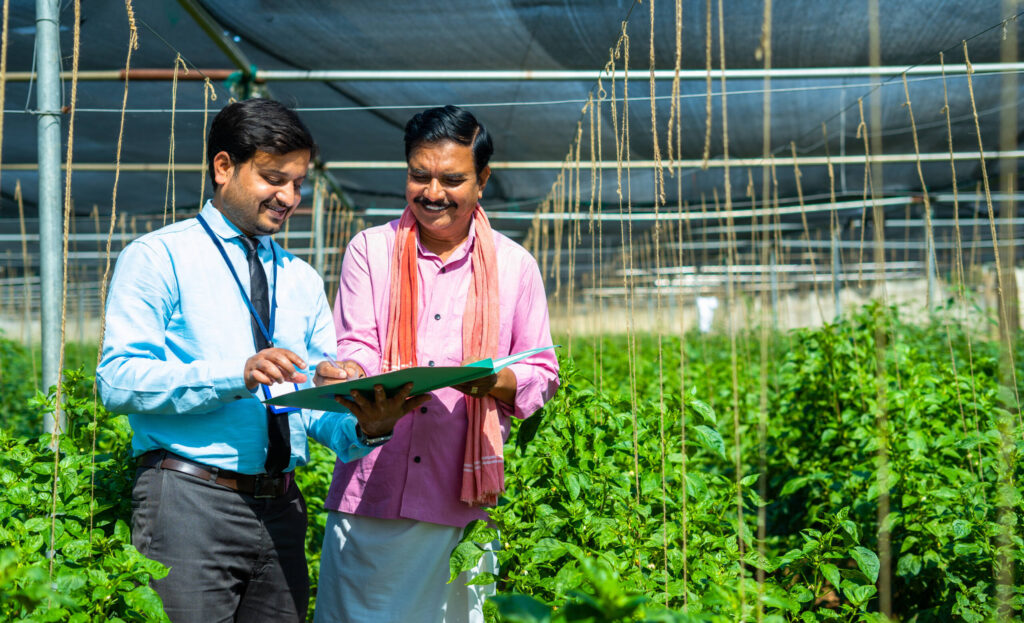
Agriculture Contract Farming
Agriculture Contract Farming is a system where a farmer agrees to grow crops or rear livestock for a buyer under a predetermined contract. The agreement typically includes specific terms regarding the production method, quality standards, and quantity of the produce. In return, the buyer provides support such as seeds, technical advice, and sometimes financing. The buyer commits to purchasing the agreed produce, often at a pre-decided price, providing the farmer with a guaranteed market.

Description of a unite model of a Vedic agriculture
As per Shastra descriptions and explanations by Kapiladev and Prithu Maharaj (pioneer of agriculture), we have created a master plan and financial model for a Vedic Eco-Village model. Each village model includes 10 subdivisions, each of 6.25 hectares (the basic unit of Vedic Agriculture or V.A.). Each V.A. model spans 16 acres (6.25 hectares or 25 Bigha), calculated locally as 50 x 50 meters or 165 x 165 meters. This model represents 25 elements: 24 material elements plus one central spiritual element.
This plan, developed over 30 years by spiritual guide His Grace Bhakta Vatsal Prabhuji (Founder of ISSCOP), has been tested in parts across various landscapes, from the deserts of Jaisalmer to the fertile lands of Habri.
Each 16-acre model, encompassing 6.25 hectares or 25 Bigha, accommodates 16 families (80 members total), 35 milking cows, and 65 non-productive cows, bulls, and oxen. Land allocation includes 64% for over 2,400 trees, 34% for crops, plants, and vegetables, 1% for a Krishna temple at the center, and 1% for family residences. Additionally, community members practice 16 essential arts, such as cloth making, Vedic medicated ghee production, blacksmithing, etc.
Bulls play a crucial role, assisting with water pumping and powering essential equipment like grinding mills, threshers, chaff-cutting machines, oil extraction machines, and also generating electricity for the community. Establishing one basic 16-acre Vedic community model takes 2 to 5 years, with the potential to yield an annual income of over ₹1 crore ($200,000+), especially when implemented in desert locations in India.

why Vedic agriculture ?
Certainly, here is the text retyped without any additions:
Because it is the only true practice of Agri-culture in which we cultivate spiritual, moral & emotional input for fulfilling the ultimate target of a human body/soul in harmony with nature to produce our food in a pure way.
Today, we have a fuel-based economy, which is destructive, while Spiritual economics is constructive and an ideal social setup.
Our Model is based on Varnasharam (an ideal social setup), which will be simultaneously established step-by-step to revive the whole social system.
Varna: As per Bg 18.42–44, there are 4 groups or varnas: Intelligent class (Brahmanas), with 9 gunas; administrative class (Kshatriya), with 7 gunas; productive class (Vaishya), with 3 gunas; and service class (Shudra), with only 1 guna.
Asharam: Age 1–25 is Brahmachari (education), 26–50 is Grihastha (interest/hard work), 51–75 is Vanaprastha (social welfare), and 75–100 is Sannyas (renunciation).
How to establish the Vedic agriculture model on 16 acres (6.25 hectares or 25 bigha)?
We divide the land into 25 parts = 24 +1
24 physical elements (5 qualities/groups)
1 Divine element
We further form these 25 parts into 6 groups:
- Tattvic (Gross layer): Earth, Water, Air, Fire, and Space
- Tanmatra (Fine layer): Sound, Touch, Rupa, Taste, and Smell
- Gyanendriya (Senses): Ear, Eyes, Nose, Tongue, and Skin
- Karmaendriya (Activity): Tongue, Hand, Leg, Anus, and Genitals
- Panch Demigods: Who supervise each group per Vaishnavs; we respect this group but concentrate on Lord Krishna
- Antariskshaindriya: Mind, Intelligence, False Ego, and Bad Consciousness
“Kaala” controls this group as Lord Krishna, which is the center of the Vedic agricultural model.
When we satisfy the center element, “Kaala,” then that is complete Spiritual Farming – Bg 4.34.
How to implement this science of Spiritual Farming on 6.25 hectares (16 acres or 25 bigha)?
We make 4 divisions, and each division has 1.5 hectares (3.25 acres), and the center element has 0.25 hectares (1 bigha).
Each division of 1.5 hectares (6 bigha) has further 2 categories:
- Minor is 4 bigha based on the names of great Goswamis: Raghunath das Goswami, Raghunath Goswami, Jiva Goswami, and Gopal Bhatta Goswami
- Major is 2 bigha based on Rupa and Sanatan Goswami to take spiritual inspiration.
We now classify 6.25 hectares (16 acres or 25 bigha) into 3 circles:
Outer Circle: Agro-Forestry to produce fodder grass/trees (16 bigha or 4 hectares)
Medium Circle: Agro-Horticulture (Agri-Silvi Pasture practice) for 19 types of agriculture in a year; 2 categories:
- Grains: maize, bajra, wheat, jowar, oats, etc.
- Fodder: gawar (for cows to help them produce milk)
Center Circle (Nucleus): consists of the following:
- Temple: 7 ft x 7 ft x 7.5 ft
- Water tank: 100 ft x 100 ft face, 50 ft x 50 ft bottom, and 10 ft depth, capacity 27000 cubic meters
- Nursery: 20 sq meters
- Vegetable Plot: 200 sq meters
- Process House & Vedic House: 60 sq meters – 4 nos. in three floors (basement, ground floor, and first floor), made from local materials only
- Medicinal Plantation: 160 sq meters (4 sections)
- Workshop for 16 kalas (arts): 80 sq meters
- Oxen-Driven Power Complex: (flour mill, pump, grain separating, grain & grass chopping, electricity generation, etc., total 14 uses)
- Cowshed: 4 divisions, each division with 5 milking cows
- Amrut Mitti/Jal: 20 sq meters
- Biogas: 25 sq meters
- Silage: Fodder storage {(3.15 sq meter x 4) + (1.25 sq meter x 4 space)}
- Seedbank: 5 sq meter x 4
- Dry Grass Storage: 8 x 320 sq meters (grains are sandwiched between dry grass)
- Sheep & Goat House or Cow Shed (for more cows): to create manure and wool, 15 sq meter x 4
- Donkey House (optional alternative for more cows): 5 sq meter x 4
- Camel: 800 sq meters
- Dogs: 4
- Horse: 1 for the boss
- Beekeeping: 25 boxes (housing for 100)
- Water Harvesting: 75000 liters x 4 tanks, space 40 sq meters
- Solar Street Light, Solar Water Purifier, Solar Heater, Solar Power System, Wind Power System, Solar Dryer, Eco Stove
- Swales for Water Stream: Supply line 125 meters = 21 inch x 18 inch; Delivery line 175 meters = 15 inch x 18 inch
- Implementation Yard: Plough, carts, agriculture tools, etc., space 10 sq meter x 40 sq meters
- Cottage Industry: 40 sq meter x 40
- Management: 16 families consist of:
- 1 Family: Grass Root Officer (G.R.O.)
- 5 Families: Production Managers (P.M.)
- 10 Families: Service Assistants (S.A.)
When we make 25 mini-villages of 6.25 hectares each, we can create a 150-hectare (400 acres or 625 bigha) Vedic Eco Village with 400 families.
Discover the Triumphs of Vedic Agriculture
Lorem ipsum dolor sit amet, consectetur adipiscing elit. Ut elit tellus, luctus nec ullamcorper mattis, pulvinar dapibus leo.

Inspired Farmer
Vedic Practitioner

Community Leader
Farming Advocate
Gallery of Success
Explore the amazing journeys of our agrarians embracing Vedic principles, showcasing their achievements and wisdom.


